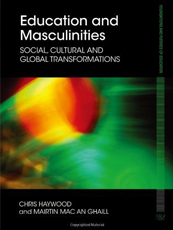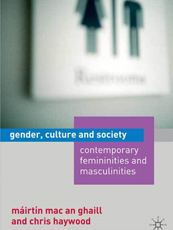Chris Haywood
What's next for masculinity?
Overview

From ‘failing boys’ to male suicide to violent young men in the media, the concept of ‘masculinity’ is often used unproblematically to explain male behaviours. But are all boys the same? Can masculinity be used to describe men’s and women’s lives? Do we still need masculinity to explain the social and cultural formation of identities?

Critically exploring gender relations in educational contexts since 1993, Chris Haywood’s recent research has focused on the concept of ‘masculinity’ over a range of publications, including books (with Máirtín Mac an Ghaill), Sociology of Men and Masculinities, Gender, Culture and Society and more recently Education and Masculinities: Social, Cultural and Global Transformations and a groundbreaking article: ‘What’s Next for Masculinity? Reflective Directions for Theory and Research on Masculinity and Education’.
Providing a comprehensive narrative of new social movement work, hegemonic masculinity, inclusive and post-masculinity approaches, Haywood challenges readers to find new ways to think through, and beyond, gender identities. His work is of significant interest to those interested in education, sociology, gender studies and those involved in the social sciences more broadly.
Context
Working concurrently on a number of articles and a book, Haywood has mapped out and tracked the different ways that ‘masculinity’ is conceptualized, offering a diagnosis of the origins and developments of current controversies.
For example, in ‘What’s Next for Masculinity’ Haywood and Máirtín Mac an Ghaill review a wide range of recent educational research to identify how masculinity is being conceptually reconfigured and to challenge and align themselves with theoretical assumptions that connect masculinity with patriarchy. Including approaches from diverse theoretical backgrounds, the authors highlight research that explores, via queer theory, the disconnection of sex from gender and that which questions the very validity of ‘masculinity’ as a conceptual frame.
Similarly, in Education and Masculinities: Social, Cultural and Global Transformations, Haywood and Mac an Ghaill focus on a number of specific themes to critically engage with the complexity and contradictions surrounding gendered identities, with chapters including:
- The social organization of masculinities: Modern schooling, reproduction and resistance
- Schooling, masculinity and class analysis: A new cultural condition in a post-colonial society
- Mediated masculinities in the news: Violence, failing boys and sex
- Masculinities across borders: Neo-liberalism, militarism and sexual health
- Feminisation, remasculation and female masculinity, and
- Thinking through masculinity: Towards a post-masculinity theory in educational contexts
Exploring how changes in the relationship between education and masculinities are linked to wider social, cultural and global transformations, the authors locate their analysis in the ‘bigger picture’ to think about how masculinities vary across contexts and offer fresh evaluation of the masculinity literature.
Outcomes
Through a number of publications, Haywood’s research has begun to dismantle the ‘artificial polarities’ that regulate gender and which rearticulate certain attitudes, behaviours and practices, without losing sight of the structuring processes that support inequalities and distribute power.
For example, in ‘What’s Next for Masculinity’, Haywood and Mac an Ghaill demonstrate how notions of masculinity and femininity can foreclose other theoretical and empirical possibilities. Offering a range of possible ‘post-masculinity’ approaches by which to think through gender as disconnected from the concept of masculinity, the final section of this article outlines a radical departure for the use of masculinities in educational research and urges researchers to produce alternative ways of thinking.
Likewise, in Education and Masculinities, Haywood and Mac an Ghaill identified how masculinities are not self-evident, but are subject to negotiation at institutional and subjective levels. For example, the authors examine how media representations of ‘academically successful girls’ and ‘failing boys’ subsume other areas of structural inequality, including age, ethnicity and class.
Providing a constructive diagnosis of both academic accounts and alternative global responses, Haywood’s work is also an appeal to researchers and educational workers alike to re-examine the interconnecting relationship between educational sites and the formation of masculine identities, to question the basis of concepts like ‘masculinity’ and to ask: is it possible to explain gender identities without the concept of masculinity? What other concepts and interventions might there be, and what might these reveal?
Further Information
Chris Haywood is currently exploring men, masculinities and dating and has recently been awarded with Dr Pauline Dixon an ESRC project exploring gender identities in Tanzanian schools.
Haywood C, MacanGhaill M. Education and Masculinities: Social, Cultural and Global Transformations. Routledge, 2013.
The following journal articles are also available:
- Haywood C, Mac an Ghaill M. 'What’s next for masculinity?' Reflexive directions for theory and research on masculinity and education. Gender and Education 2012, 24(6), 577-592.
- Mac an Ghaill M, Haywood C. Schooling, masculinity and class analysis: towards an aesthetic of subjectivities. British Journal of Sociology of Education 2011, 32(5), 729-744.
- Mac an Ghaill M, Haywood C. Understanding boys': Thinking through boys, masculinity and suicide. Social Science and Medicine 2012, 74(4), 482-489.
- Mac an Ghaill M, Haywood C. ‘Nothing to write home about’: Troubling concepts of home, racialization and self in theories of Irish male (e)migration. Cultural Sociology 2011, 5(3), 385-402.
